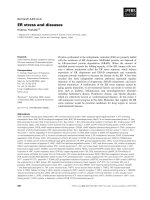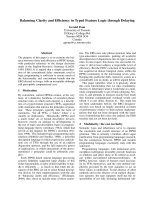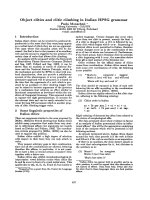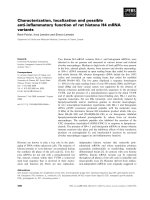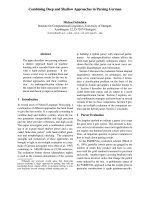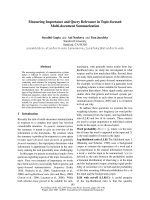Báo cáo khoa học: "Job stress and job satisfaction of physicians, radiographers, nurses and physicists working in radiotherapy: a multicenter analysis by the DEGRO Quality of Life Work Group" ppt
Bạn đang xem bản rút gọn của tài liệu. Xem và tải ngay bản đầy đủ của tài liệu tại đây (380.14 KB, 9 trang )
Radiation Oncology
Short report
Job stress and job satisfaction of physicians, radiographers, nurses
and physicists working in radiotherapy: a multicenter analysis by
theDEGROQualityofLifeWorkGroup
Susanne Sehlen*
1
,DirkVordermark
2
,ChristofSchäfer
3
, Peter Herschbach
4
,
Anja Bayerl
5
, Steffi Pigorsch
6
, Jutta Rittweger
7
, Claudia Dormin
8
,
Tobias Bölling
9
, Hans Joachim Wypior
10
, Franz Zehentmayr
11
,
Wolfgang Schulze
12
and Hans Geinitz
6
Address:
1
Department of Radiotherapy and Radiooncology, University Munich, Munich, Germany,
2
Department of Radiotherapy and
Radioonc ology, University Würzburg/Halle, Würzburg, Germany,
3
Department of Radiotherapy and Radiooncolog y, University Regensburg,
Regensbu rg, Germany,
4
Institute of Psychosomatic Medicine, Psychotherapy and Medical Psychology, Technical Univer sity Munich, Munic h,
Germany,
5
Department of Radiotherapy and Radiooncolog y, Vienna, Austria,
6
Department of Radiotherapy and Radiooncolog y, Technical
University Munich, Munich, Germany,
7
Department of Radiotherapy and Radiooncology, University Halle, Halle, Germany,
8
Department of
Radiotherapy and Radiooncology, University Frankfurt, Frankfurt, Germany,
9
Department of Radiotherapy and Radiooncology, University
Münster, Münster, Germany,
10
Department of Radiotherapy and Radiooncology, General Hospital Landshut, Germany,
11
Department of
Radiotherapy and Radiooncology, University Salzburg, Austria and
12
Department of Radiotherapy and Radiooncology, General Hospital
Bayreuth, Bayreuth, Germany
E-mail: Susanne S ehlen* - ; Dirk Vordermark - ;
Christof Schäfer - chris ; Peter Herschbach - ; Anja Bayerl - ;
Steffi Pigorsch - ; Jutta Rittweger - Rjutta@t -online.de; Claudia Dormin - ;
Tobias Bölling - ; Hans Joachim Wypior - ; Franz Zehentmayr - ;
Wolfgang Schulze - ; Hans Geinitz - muenchen.de
*Correspondi ng author
Publishe d: 06 February 2009 Received: 29 September 2008
Radiation Oncology 2009, 4:6 doi: 10.1186/1748-717X-4-6 Accepted: 6 February 2009
This article is available from: />© 2009 Sehlen et al; licensee Bi oMed Central Ltd.
This is an Open Access article distributed under the terms of the Creativ e Commons Attribution License (
/>which permits unrestricte d use, distribution, and re production in any medium, provided the original work is properly cited.
Abstract
Background: Ongoing changes in cancer care cause an increase in the complexity of cases which
is characterized by modern treatment techniques and a higher demand for patient information
about the underlying disease and therapeutic options. At the same time, the restructuring of health
services and reduced funding have led to the downsizing of hospital care services. These trends
strongly influence the workplace e nvironment and are a potential source of stress and burnout
among professionals working in radiotherapy.
Methods and patients: A postal survey was sent to members of the workgroup "Quality of Life"
which is part of DEGRO (German Society for Radiooncology). Thus far, 11 departments have
answered the survey. 406 (76.1%) out of 534 cancer care workers (23% physicians, 35% radiographers,
31% nurses, 11% physicists) from 8 university hospitals and 3 general hospitals completed the FBAS
form (Stress Questionnaire of Physicians and Nurses; 42 items, 7 scales), and a self-designed
questionnaire regarding work situation and one question on global job satisfaction. Furthermore, the
participants could make voluntary suggestions about how to improve their situation.
Results: Nurses and physicians showed the highest level of job stress (total score 2.2 and 2.1).
The greatest source of job stress (physicians, nurses and radiographers) stemmed from structural
Page 1 of 9
(page number not for citat ion purposes)
BioMed Central
Open Access
conditions (e.g. underpayment, ringing of the telephone) a "stress by compassion" (e.g. "long
suffering of patients", "patients will be kept alive using all available resources against the conviction
of staff"). In multivariate analyses professional group (p < 0.001), working night shifts (p = 0.001 ),
age group (p = 0.012) and free ti me compensation (p = 0.02 4) gained significance for total FBAS
score.Globaljobsatisfactionwas4.1ona9-pointscale(from1– very satisfied to 9 – not satisfied).
Comparing t he total stress scores of the hospitals and job groups we fou nd significant differen ces in
nurses (p = 0.005) and physicists (p = 0.042) and a borderline signi ficance in physicians (p = 0.052).
In multivariate analyses "professio nal group" (p = 0.006) and "vocatio nal experience" (p = 0.036)
were associated with job satisfaction (cancer care workers with < 2 years of vocational experience
having a higher global job satisfaction). The total FBAS score correlated with job satisfaction
(Spearman-Rho = 0.40; p < 0.001).
Conclusion: Current workplace environments have a negative impact on stress levels and the
satisfaction of radiotherapy staff. Identification and removal of the above-mentioned critical points
requires various changes which should lead to the reduction of stress.
Background
TheHealthcaresystemsareundergoingmajorstructural
and financial changes. Ongoing changes to cancer care
include an increase in the complexity of cases, available
treatment options and better informe d patients. One
important new stressor is the increasing complexity of
multimodal cancer treatment with difficulties for the
individual health professionals to govern the treatment
in all its details [1-6]. Especially in radiation oncology
treatment has become progressively more complex
within the past 10 to 15 years. Additional challenges
are added with the growing proportion of cancer in the
elderly caused by an augmented life expectancy in
developed countries. At the same time health services
restructuring and reduced public spending has lead to
downsizing of hospital care services [7]. These factors
contribute to an increased individual workload for the
hospital staff.
Breaking bad news is one of a radiotherapists most
difficult duties, yet medical education typically offers
little formal preparation for this important task [8, 9].
Without proper training, the discomfort and uncertainty
associated with br eaking bad n ews may lead physicians
to em otion ally distress.
Distress can lead to erosion of patient compliance which
generates new distress for hospital staff [7]. [10]. In
oncology additional strain is produced by the frequency
of the deliverance of bad news and dealing with patient's
death and suffering [11].
These imbalances with increasing demand of human and
material resources on the one hand side and a lack of
sufficient financial sources on the other side have
produced a negative influence on the workplace envir-
onment and are potential sources of stress and burnout
of cancer care workers in radiotherapy [12]. The impetus
for the study was to analyze factors for stress and job
satisfaction of cancer care workers within the context of
different radiotherapy departments in Germany and
Austria.
Methods and study populations
Recruiting of radiotherapy facilities
Radiotherapy facilities were recruited via the working
group "quality of life" (Arbeitskreis "Lebensqualität")
within the German Society of Radiation Oncology
(DEGRO). Members of the working group were asked
whether they were willing to locally carry out the study
within their department ("local study coordinator").
Each local study coordinator was responsible for the
information and mobilisation of the cancer care workers
(physicians, radiographers, nurses, physicists) within his
radiation oncology facility as well as for the distribution
and recollection of the questionnaires. The local study
coordinators were mailed a study protocol that provided
guidelines for recruiting the participants and the ques-
tionnaires (see below). In addition they were asked to
collect data on the clinic equipment, number of cancer
care workers and patient load. The questionnaires could
be allocated to the participating centre but not to the
individual. For each hospital the works committees gave
consent to proceed with the study. The study was carried
out from August 2006 to February 2007.
Questionnaires
Each cancer care worker was asked to give basic data on
the category of her/his professional group, her/his age
(four categories), gender, years of vocational experience
(four categories), wether she/he was working night shifts
or working on weekends and if she/he was getting free
time compensation.
Radiation Oncology 2009, 4:6 />Page 2 of 9
(page number not for citat ion purposes)
Job stress was evaluated with the "Fragebogen zur
Belastung von Ärzten/Ärztinnen und Krankenpflegekräf-
ten" ("Questionnaire for Ascertaining Stress on Doctors
and Nurses", Her schba ch 198 9 [13]). The validated
questionnaire comprises 42 items. Each item was self-
scored with the five categorized answers "not at all", "a
little", "a little more", "quite a bit", or "a lot". Higher scores
are associated with higher stress. The questionnaire is
subdivided into 5 scales: "structural conditions" (e. g.
"underpayment", "permanent ringing of the telephone"),
"stress by compassion" (e.g. "against the conviction
patients were kept alive with all resorts"), "problems with
colleagues", "inconvenient patients" and finally "profes-
sional/private life" (e.g. "disruption of home life through
spending long hours at work"). In addition a total score
was built comprising of all 42 items (Fig. 1).
Figure 1
" Stress Questionnaire of physicians and nurses (FBAS), Herschbach 1989.
Radiation Oncology 2009, 4:6 />Page 3 of 9
(page number not for citat ion purposes)
Global job satisfaction was evaluated with an ad hoc
constructed one dimensional scale with nine categorical
answers (1: very high job satisfaction to 9: total job
dissatisfaction).
Data analysis
The data analysis was carried out with the programme
SPSS™ 14. for Windows. Influencing factors on job stress
and sati sfact ion were analy zed using the Mann-Whitney
Test or the Kruskall Wallis Test. Stepwise multiple linear
regression ana lysis was perfor med for multivari ate
analyses. All tests were carried out two-sided. A p-level
of 0.05 or below was considered to be significant.
Results
11 radiotherapeutic treatment facilities in Germany and
Austria participated in the study (8 universities, 3 general
hospitals) comprising 534 cancer care workers. The
overall response r ate was 76.1% (n = 406), characteristics
of the participants are given in table 1.
Job stress
Nurses and physicians showed the highest levels of job
stress (mean FBAS total score 2.2 and 2.1, respectively),
whereas radiographers (mean total score 1.7) and
physicists (mean total score 1.0) disclosed lower levels
of job stress (p < 0.001) (table 2). For physicians, nurses
and radiographers the highest stress rates were caused by
"structural conditions" and "stress by compassion"
(table 2). Physicists reported in all low stress levels
with the highest score values in the scales "structural
conditions" and "problems with colleagues". On the
item level the four greatest sources of physician's job
stress were" too much office work" (mean score 3.4),
"time pressure" (mean score 3.36), "ill-defined respon-
sibilities" (mean score 3.13) and "breaking off the
conversation with the patient" (mean score 3.10). For
nurses the greatest stress f actors stemmed from "perma-
nent ringing of telephone" (mean score 3.53), "against
the conviction patients were kept alive by all means"
(mean score 3.22), "underpayment" (mean score 3.21)
and "time pressure" (mean score 3.11). Radiographers
rated the following items as the most stressing: "against
the conviction patients were kept alive by all means"
(mean score 2.88), "stress due to patient's disease
progression" (mean score 2.79), "high physical work-
load" (mean score 2.76) and "patie nts suffering of my
therapy" (mean score 2.74). Physicists expressed as
sources of stress "time pre ssure" (mean score 2.82),
"underpayment" (mean score 2.34), "ill-defined respon-
sibilities" (mean score 2.19) and "reduction of private
life through high workload" (mean score 2.16) (table 3).
Besides professional group the following variables were
tested for their association with the FBAS total stress score
and with 5 FBAS scales: age category (20-<30, 30-<40, 40-
<50, 50-<60, ≥ 60 years) gender, vocational experience (<2,
Tab le 1: Participants' characteristics
N (total n = 406) percent
professional groups
physicians 82 22,7
nurses 113 31,2
radiographers 128 35,4
physicists 39 10,8
not available 44
gender
female 285 73,6
male 102 26,4
not available 19
age categories
20–29 years 93 23,4
30–39 years 113 28,5
40–49 years 120 30,2
50–59 years 65 16,4
≥ 60 years 6 1,5
not available 9
vocational
experience
< 2 years 52 13,0
2-<5 years 65 16,3
5-<10 years 87 21,8
≥ 10 years 196 49,0
not available 6
work load
≤ 160 hours/months 225 58,3
> 160 hours/months 161 41,7
not available 20
Working night
shifts
no 267 69,9
yes 115 30,1
not available 24
Free time
compensation
no 116 28.9
yes 286 71.1
not available 4
Working on
weekends
no 195 50,6
yes 190 49,4
not available 21
Night call/weekend
call duties
no 304 80,4
yes 74 19,6
not available 28
Radiation Oncology 2009, 4:6 />Page 4 of 9
(page number not for citat ion purposes)
2-<5, 5-<10, ≥ 10 years), work load (≤ 160 vs. > 160 hours/
months), working night shifts (yes vs. no), Night call/
weekend call duties (yes vs. no), working on weekends (yes
vs. no) and possibility of free time compensation (yes vs.
no). In univariate analysis the the following variables were
associated with more job stress: total FBAS score: working
night shifts (p < 0.001) and working on weekends
(p < 0.001); "structural conditions": working night shifts
(p < 0.001), working on weekends (p < 0.001) and no free
time compensation (p = 0.013); "stress by compassion":
female gender (p = 0.038), working night shifts (p < 0.001)
and working on weekends (p < 0.001); "problems with
colleagues": age < 50 years (p = 0.024); "inconvenient
patients": working night shifts (p < 0.001) and working on
weekends (p < 0.001); "professional/private life": male
gender (p = 0.006), working night shifts (p < 0.001), Night
call/weekend call duties (p < 0.001), working on weekends
(p < 0.001), no free time compensation (p < 0.001) and
working more than 160 hours/months (p = 0.001).
Comparing the total stress scores of the hospitals and job
groups we found signi ficant differences in nurses
(p = 0.005) and physicists (p = 0.042) and a borderline
significance in physicians (p = 0.052) (Figure 2).
In addition to the above mentioned variables the
hospital was included in the multivariate analyses. The
following parameters gained significance: total FBAS
score: professional group (p < 0.001), working night
shifts (p = 0.001), age group (p = 0.012) and free tim e
compensation (p = 0.024); "structural conditions":
professional group (p < 0.001), working on weekends
(p = 0.005) and working night shifts (p = 0.042); "stress
by compassion": professional group (p < 0.001), no
free time compensation (p < 0.001) and age group
(p = 0.032); "problems with colleagues": age
group (p = 0.046); "inconvenient patients": professional
group (p < 0.001), age group (p < 0.001) , no free t ime
compensation (p < 0.001) and working night shifts
(p < 0.001); "professional/private life": working on
weekends (p = 0.00 2), w orking night shift s (p = 0.003),
professional group (p = 0.015) and no free time
compensation (p = 0.005).
Table 2: FBAS – stress items and profession
Item Total Physician
Mean SD
Nurse
Mean SD
Radiographer
Mean SD
Physicist
Mean SD
"too much office work" 2.15 3.40 2.39 1.21 2.15
±1.73 ±1.42 ± 1.69 ± 1.48 ± 1.45
"having confli cting demands on the time" 2.95 3.36 3.11 2.70 2.82
±1.62 ±1.47 ± 1.76 ±1.57 ±1.50
"illdefined responsibilities" 2.57 3.13 2.78 2.15 2.19
±1.67 ±1.52 ± 1.60 ± 1.73 ± 1.65
"breaking off a conversation with the patient" 2.40 3.10 2.80 2.17 0.31
±1.68 ±1.54 ± 1.52 ± 1.60 ± 0.87
"disru ption of home life through spending long
hours at work"
1.88 2.82 1.31 0.88 2.16
± 1.89 ± 1.93 ± 1.66 ± 1.54 ± 1.78
"underpayment" 2.89 3.07 3.21 2.64 2.34
± 1.74 ± 1.74 ± 1.67 ±1.74 ±1.74
"permanent ringing of t elephone" 2.70 2.76 3.53 2.26 1.76
± 1.74 ± 1.78 ± 1.46 ± 1.83 ± 1.62
"against the conviction patients were kept
alive with all resorts"
2.45 1.37 3.22 2.88 0.70
± 1.88 ± 1.62 ± 1.79 ± 1.69 ±1.16
"stress due to patient's disease progression" 2.71 2.71 2.93 2.79 1.21
± 1.42 ± 1.35 ± 1.41 ± 1.21 ±1.62
"high physical workload" 2.18 1.16 2.84 2.76 0.64
± 1.66 ± 1.38 ± 1.69 ± 1.33 ±0.90
"patients suffering of my therapy" 2.20 1.93 2.23 2.74 0.42
± 1.67 ± 1.51 ± 1.77 ± 1.53 ±1.09
Radiation Oncology 2009, 4:6 />Page 5 of 9
(page number not for citat ion purposes)
Job satisfaction
Like job stress satisfaction was associated with profes-
sional group: physicists had the highest satisfaction
values whereas the other professional groups had clearly
lower levels without much difference in between the
three groups (figure 3). There were no other factors that
were associated with job satisfaction in univariate
analyses.
In multivariate analyses "professional group" (p =
0.006) and "vocational experience" (p = 0.036) were
associated with job satisfaction, with canc er care workers
with less than two years of vocational experience having
a higher global job satisfaction. The total FBAS score
correlated with job satisfaction (Spearman-Rho = 0.40;
p < 0.001).
Discussion
In this paper we report on job stress and job satisfaction
of cancer care workers in radiation oncology clinics in
Germany and Austria. Although the sample of hospitals
Table 3: FBAS scales/total score and job stress
scale Mean Standa rd deviation Significance
structural conditions physician 2.5856 .98258
nurse 2.7603 1.13287 P < 0.001
radiographer 2.0297 .94769
physicist 1.4447 .91103
compassion physician 2.1598 .85505
nurse 2.2913 .98817 P < 0.001
radiographer 2.0265 .79141
physicist .8518 .75022
inconvenient patients physician 2.0434 .88469
nurse 2.1789 1.02272 P < 0.001
radiographer 1.5164 .78164
physicist .3110 .65245
job/pr ivat e life physician 1.8317 1.35409
nurse 1.5705 1.31611 P < 0.001
radiographer .5515 .80870
physicist 1.0128 .97877
problems with colleagues physician 1.7175 1.02362
nurse 1.7637 1.07077 n.s.
radiographer 1.8832 1.08493
physicist 1.4808 1.15781
total score physician 2.1368 .78242
nurse 2.2125 .89627 P < 0.001
radiographer 1.7320 .70041
physicist .9616 .64292
p=0.005
p=0.052
n.s
p=0.042
0
0,5
1
1,5
2
2,5
3
3,5
4
physicians nurses radiographers physicists
1
2
3
4
5
6
7
8
9
10
11
12
Total
Figure 2
Total score of job stress- profession group and clinic
n.s not significant.
Figure 3
Satisfaction and professional group.
Radiation Oncology 2009, 4:6 />Page 6 of 9
(page number not for citat ion purposes)
is not representative for all radiation therapy facilities in
both countries the collected data fits to previously
published reports in other countries. This is the first
published survey of its kind conducted in German
speaking countries. Considering the high response rate
the data should adequately mirror job stress in the 11
participating hospitals and could serve as a source for
generating hypotheses. Since nearly three quarters of the
participating centres were university hospitals extrapola-
tion to non-university facilities should be carried out
with caution.
The findings of our study indicate that job stress levels
vary between professional groups. Physicians and nurses
rated their job stress higher than radiographers and
medical physicists. Job stress also stemmed from
different sources in between professional groups: physi-
cians, nurses and radiographers were mostly stressed by
structural conditions and compassion whi le physicists
were stressed -although b y a much lower level- by
structural conditions and problems with colleagues. This
is in line with the lower patient contacts of physicists in
routine clinical wor k. Since the total stress score
correlated with satisfaction medical physicists also
disclosed higher job satisfaction levels than the other
professional groups.
With the aging of the population there will be a growing
demand to recruit health care professionals -especially in
oncology. On t he other hand birth rates are low almost
all over the European Union [14]. and will most likely
result a shortage in skilled personnel within the next
years. The health care system has to find ways to attract
young people to find their professional career within this
system and -almost as important- to provide conditions
that they stay within this vocation. Job stress is an
important factor for cancer care workers to consider
alternative work situations [15].
Job stress in itself is not only disturbing for the working
health care individual but can also have a profound
effect on the interaction with the patient considering that
patient in oncology, especially in radiotherapy, have a
high stress level distress [ 16-18]. Increasing evidence
suggests that physician distress can lead to er osion of
physician com passion [1, 19], patient compliance [10]
and the quality of care physicians deliver [1, 20].
Physicians under stress are reported to have a higher
tendency in treating patients poorly both medically and
psychologically [21]. They are also more likely to make
errors of judgement.
Personal, interpersonal and organisational factors have
been reported to relate to job stress. One of the
organisational factors that required a highly increased
workload from health professionals in the past years is
documentation. Einhorn et al. conducted a postal survey
in 2.493 US oncologists [22]. They report that increased
documentation caused the greatest concern among
respondents and negatively influenced job satisfactio n.
More than 40% reported that high documentation
workload lead to diminished patient care and decreases
in t eaching (48%) and research (39%). In concordance
with the results of Einhorn et al. [22]. physicians in our
study ranked "too much office work" as the highest job
stressor greatly surpassing other factors commonly
thought to be associated with job strain in oncology
like "stress due t o patient's disease progression".
Further important structural conditions that caused high
stress among participants weretimepressure("having
conflicting demands on the time", "breaking off a
conversation with the patient" and "permanent ringing
of the telephone") as well as "underpayment" and "high
physical w orkload". Grunfeld et al. carried out a survey
in 681 cancer care workers in Ontario [15]. They found
that "having too great volume of work", "having
inadequate staffing to do the job properly", ""feeling
under pressure to make deadlines" and "having conflict-
ing demands on time" were mayor derminants of job
stress. Ernst and colleagues surveyed 249 pediatric nurses
and found that pay was one of the mayor determinants
of job stress [23].
Cancer care workers in our study reported more job
distress when they were working night shifts, and
weekends or were not getting free time compensation
for working long hours. Data from Ǻrkerstedt et a l.
support the notion that night time work is hazardous to
a persons' long term well being [24]. For phys ic ians,
nurses and radiographers "structu ral conditions" and
"patient-compassion" were the major causes of their
stress. Documentat ion/paperw ork decreases the abili ty
of cancer care workers to spend time with the ir patients.
Growing incidence of stress by medical s pecialists can be
caused by recent changes in society. Patients are better
informed, more critical and better protected by law [25].
In addition job security has diminished and plays a
major role. Grunfeld et al. [15]. in their analysis of 681
cancer care workers in Canada disclosed that job stress
increased with workload. To reduce job stress of cancer
care workers in radiation oncology measures should be
undertaken to improve the structural conditions within
the departments. Such measures could be: better defini-
tions of responsibilities for the individual cancer care
worker, delegation of office work to other professional
groups (e. g. data managers, secretaries), optimization
of work processes (quality management) and training of
communication skills and conf lict solving strategies of
all professional groups. Several authors showed for
Radiation Oncology 2009, 4:6 />Page 7 of 9
(page number not for citat ion purposes)
example that stress for hospital nurses correlated with
conflict of doctors [26]. They have to accept that death is
an intrinsic factor of their profession. Thus cancer care
workers have to learn to function at an optimal
emotional and intellectual level despite such strong
stressors [27]. A better balance may be obtained between
timespentatworkandtimespentathome.
Stress by compassion and inconvenient patients were
higher among nurses than among phys icians and radio-
graphers. In agreement with other investigators we found
factors that may be greater sources of stress for women
physicians [28]. "The cancer car e worke rs in this survey
felt that the mean level of stress in dependence of years
of vocational experience was similar. These response
suggest that the stress does not get better after comple-
tion of training. Efforts to debunk the myth of "things
getting better" early in training and instead emphasize
the importance of developing balance and strategies for
promoting personal wellness may be warranted" [16].
Although the response rate is high for a physician survey,
response bias remains a possible confounding factor
[29]. Objective job stress like the actual number of hours
the participants had to work or if they were on
temporary employment was not directly measured in
this survey but the fact that subjective job stress
correlated with working night shifts and working week -
ends does indicate that both measures -objective and
subjective- are closely related.
Job stress in this sample of cancer care workers in
radiation oncology departments is highly determined by
structural conditions followed by problems related to
patient compassion. As in Germany and Austria health
care workers and in particular physicians are in short
supply opinion leaders inhealth care politics and hospital
administrators should try to focus their attention on how
to improve structural conditions and job satisfaction for
this group of professionals. Besides of accepting job stress
as a problem in the field of health care future studies and
strategies might encompass a reduction of the individual
work load, optimization of work processes, a shift of
office work onto other professional groups, training of
communication and conflict solving skills and strategies
for promoti ng personal wellness and an even ba lance of
professional and private life.
Competing interests
The authors declare that they have no competing interests.
Authors' contributions
SS and HG conceived of the study, and participated in its
design and coordination, performed the statistical
analysis and drafted the manuscript. DV and CS
conceived of the study, participated in its design and
coordination, carried out the analysis in the centres and
drafted the manuscript. AB, SP, JR, CD, TB, HJW, FZ and
WS carried out the analysis in the different centres. PH
conceived of the study, participated in its design and
drafted the manuscript.
References
1. Firth-Cozens J and Greenhalgh J: Doctors' perceptions of the
link between stress and lowered clinical car e. Soc Sci Med
1997, 44:1017–1022.
2. Deantonio L, Beldì D, Gambaro G, Loi G, Brambilla M, Inglese E and
Krengli M: FDG-PET/CT imaging for staging and radio-
therapy treatment planning of head and neck carcinoma.
Radiat Oncol 2008, 18(3):29.
3. Sharma N, Neumann D and Macklis R: The impact of functional
imaging on radiation medicine. Radiat Oncol 2008, 3:25.
4. Schuring D and Hurkmans CW: Dev eloping and evaluating
stereotactic lung RT trials: what we should know about the
influence of inhomogeneity corrections on dose. Radiat Oncol
2008, 28(3):21.
5. Lindvall P, Bergström P, Löfroth PO, Henr iksson R and
Bergenheim AT: Reproducibility and geometric accuracy of
the Fixster system during hypofractionated stereotactic
radiotherapy. Radiat Oncol 2008, 28(3):16.
6. Singh A K, Guion P, Sears-Crouse N, Ullman K, Smith S, Albert PS,
Fichtinger G, Choyke PL, Xu S, Kruecker J, Wood BJ, Krieger A and
Ning H: Simultaneous integrated boost of biop sy proven, MRI
defined dominant intra-prostatic lesions to 95 Gray with
IMRT: early results of a phase I NCI study. Radiat Oncol 2007,
18(2):36.
7. Iglehart JK: Revisting the Canadian Health Care System. New
Engl J Med 2000, 342(26):2007–2012.
8. Ramirez AJ, Graham J, R ichards MA, Cull A and Gregory WM:
Mental health of hospital consultants: the effect of job stress
and job satisfaction at work. Lancet 1996, 347:724– 728.
9. Sch äfer C and Herbst M: Ethical aspects of patient information
in radiation oncology. An introduction an d a review of the
literature. Strahlenther Onkol 2003, 179(7):431– 40.
10. DiMatteo MR, Sherbourne CD, Hays RD, Ordway L, Kravitz RL,
McG lynn EA, Kaplan S and Rogers WH: Physicians' characterer-
istics influence patients' adherence to medical streatment:
Results from th e Medical Outcomes S tudy. Health Psychol
1993, 12:93–102.
11. Shanafelt T, Chung H, Whit e H and Lyckholm LJ: Shaping your
career to maximize personal satisfaction in the practice of
oncology. JClinOncol2006, 24(24):4020– 6.
12. Melville A:
Job satisfaction in gen eral practice: implications
for prescribing. Soc Sci Med [Med Psychol Med Sociol] 1980, 14A
(6):495–9.
13. Herschbach P: Psychische Belastung von Ärzten und Kran-
kenpflegekräften. Weinheim 1991.
14. Tarnow-Mordi WO, Hau C, Warden A and Shearer AJ: Hospital
mortali ty in relation to staff workload: a 4- year study in
adult intensive care un it. Lancet 2000, 356:185–189.
15. Grunfeld E, Zitzelsbe rger L, Coristine M, Whelan TJ, Aspelund F and
Evans WK: Job stress and job satisfaction of cancer care
workers. Psychooncology 2005, 14(1):61–9.
16. Shanafelt TD, Novotny P, Johnson ME, Zhao X, Steensma DP,
Lacy MQ, Rubin J and Sloan J: The well-being and personal
wellness promotion strategies of medical oncologists in the
North Central Cancer Treatment Group. Oncology 2005, 68
(1):23–32.
17. Chäfer C, Di etl B, Putnik K, Altmann D and Mari enhagen J: Patient
information in radiooncology results of a patient survey.
Strahlenther Onkol 2002, 178(10):562–71.
18. Sehlen S, Hollenhorst H, Schymura B, Firsching M, Aydemir U,
Herschbach P and Dühmke E: Disease specific stress of tumor
patients at the beginning of radiotherapy. Effects on
psychosocial support requirement. Strahlenther Onkol 2001,
177(10):530–7.
19. Bellini LM, Baime M and Shea JA: Variation of mood and
empathy during internship. JAMA 2002, 287(23):3143–6.
20. Sehlen S, Holle nhorst H, Schymura B, Herschbach P, Aydemir U,
Firsching M and Dühmke E: Psychosocial stress in cancer
Radiation Oncology 2009, 4:6 />Page 8 of 9
(page number not for citat ion purposes)
patients during and after radiotherapy. Strahlenther Onkol 2003,
179(3):175–80.
21. Arnetz BB: Psychosocial challenges faci ng physicians of today.
Soc Sci Med 2001, 52(2):203–13.
22. Einhorn LH, Levin son J, Li S , Lamar L, Kamin D and Mendelson D:
American Socie ty of Clinical Oncology 2001 Presidential
Initiative: impact of regulatory burdens on quality cancer
care. JClinOncol2002, 20(24):4722–6.
23. Ernst ME, Messmer PR, Franco M and Gonzalez JL: Nurses' job
satisfaction, stress, and recognition in a pediatric setting
setting. Pediatr Nurs 2004, 30(3):219–27, Erratum in: Pediatr Nurs.
2005, 31(1):20.
24. Akerstedt T: Psychological and psychophysio logical effects of
shift work. Scan d J Work Environ Health 1990, 16:67–73.
25. Dyer C: GPs faced escalating li tigation. BMJ 1999, 318: 830.
26. Shanafelt TD, Bradley KA, Wipf J E and Back AL: Burnout and self-
reported patient care in an internal medicine residency
program. AnnInternMed2002, 136(5):358–67.
27. Mc Cue JD: The effects of stress on physicians and their
medical pr actice. New Engl J Med 1982, 306:458–463.
28. Frank E, McMurray JE and Linzer M, et al: Career satisfaction od
US women physicians: Results from the Women Physicians'
Health study. Society of General Internal medicine Career
Satisfaction Study Group. Arch Intern Med 1999, 159:1417–1426.
29. Kellermanan S and Herold J: Ph ysician response to surveys. A
review of sthe literatu re. Am J Prev Med 2001, 20:61–71.
Publish with Bio Med Central and every
scientist can read your work free of charge
"BioMed Central will be the most significant development for
disseminating the results of biomedical research in our lifetime."
Sir Paul Nurse, Cancer Research UK
Your research papers will be:
available free of charge to the entire biomedical community
peer reviewed and published immediately upon acceptance
cited in PubMed and archived on PubMed Central
yours — you keep the copyright
Submit your manuscript here:
/>BioMedcentral
Radiation Oncology 2009, 4:6 />Page 9 of 9
(page number not for citat ion purposes)
